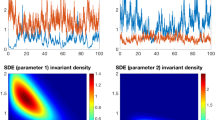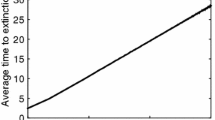Abstract
We consider a general class of Markov population models formulated as stochastic difference equations. The population density is shown to converge either to 0, to +∞, or to a unique stationary distribution concentrated on (0, +∞), depending on the signs of the mean log growth rates near 0 and +∞. These results are applied to the Watkinson-MacDonald “bottleneck” model of annual plants with a seedbank, extended to allow for random environmental fluctuations and competition among co-occurring species. We obtain criteria for long-term persistence of single-species populations, and for coexistence of two competing species, and the biological significance of the criteria is discussed. The lamentably few applications to the problem at hand of classical limit-theory for Markov chains are surveyed.
Similar content being viewed by others
References
Acevedo L. M. F.: On Horn's Markovian model of forest dynamics with particular reference to tropical forests. Theoret. Pop. Biol. 19, 230–250 (1981)
Angevine, M. W., Chabot, B. F.: Seed germination syndromes in higher plants. In: Solbrig, O. T., Jain, S., Johnson, G. B. and Raven, P. L., Topics in Plant Population Biology. New York: Columbia University Press, 1979
Bartlett, M. S.: Stochastic population models in ecology and epidemiology. London: Methuen, 1960
Beatley, J. C.: Phenological events and their environmental triggers in Mojave desert ecosystems. Ecology 55, 856–863 (1974)
Bierzychudek, P.: Life histories and demography of shade-tolerant temperate forest herbs: a review. New Phytol. 90, 757–776 (1982)
Chesson, P. L.: Predator-prey theory and variability. Ann. Rev. Ecol. Syst. 9, 323–347 (1978)
Chesson, P. L.: The stabilizing effect of a random environment. J. Math. Biology 15, 1–36 (1982)
Chesson, P. L.: Coexistence of competitors in a stochastic environment: the storage effect, pp. 188–198. In: Freedman, H. I., Strobeck, C., eds. Population Biology (Lecture Notes in Biomathematics 52). Berlin-Heidelberg-New York: Springer 1983
Chesson, P. L., Warner, R. R.: Environmental variability promotes coexistence in lottery competitive systems. Amer. Natur. 117, 923–943 (1981)
Cohn, H.: On the convergence of stochastically monotone sequences of random variables and some applications. J. Appl. Prob. 18, 592–605 (1981)
Comins, H. N., Hamilton, W. D., May, R. M.: Evolutionary stable dispersal strategies. J. Theoret. Biol. 32, 205–230 (1980)
Derrienec, Y., Lin, M.: On invariant measures and ergodic theorems for positive operators. J. Funct. Anal. 13, 252–267 (1973)
Ellner, S.: Evolutionarily stable germination behaviors in randomly varying environments. Ph.D. thesis, Cornell University, Ithaca, N.Y. 1982
Evenari, M., Shanan, L., Tadmor, N.: The Negev: The Challenge of a Desert. Cambridge, Mass: Harvard University Press, 1971
Fagerström, T., Ågren, G. I.: Theory for coexistence of species differing in regeneration properties. Oikos 33, 1–10 (1979)
Flåm, S. D.: Steady states in population models with monotone, stochastic dynamics. J. Math. Biology 13, 87–93 (1981)
Foguel, S. R.: Existence of a σ-finite invariant measure for a Markov process on a locally compact space. Israel J. Math. 6, 1–5 (1968)
Foguel, S. R.: The ergodic theory of Markov processes. New York: Van Nostrand Reinhold, 1969
Foguel, S. R.: The ergodic theory of positive operators on continuous functions. Ann. Scuola. Norm. Sup. Pisa 27, 19–51 (1973)
Fowler, N. L., Antonivics, J.: Small-scale variability in the demography of transplants of two herbaceous species. Ecology 62, 1450–1457 (1981)
Gillespie, J.: Polymorphism in random environments. Theoret. Pop. Biol. 4, 193–195 (1973)
Grubb, P. J.: The maintenance of species richness in plant communities. The importance of the regeneration niche. Biol. Rev. 52, 104–145 (1977)
Hamilton, W. D.: May, R. M.: Dispersal in stable habitats. Nature 269, 578–581 (1977)
Harper, J. L.: Population Biology of Plants. New York: Academic Press 1977
Hartl, D. L., Cook, R. D.: Balanced polymorphism of quasineutral alleles. Theoret. Pop. Biol. 4, 163–172 (1973)
Heckel, D. G., Roughgarden, J.: A species near its equilibrium size in a fluctuating environment can evolve a lower intrinsic rate of increase. Proc. Natl. Acad. Sci. USA, 77, 7497–7500 (1980)
Hubbell, S. P.: Seed predation and the coexistence of tree species in tropical forests. Oikos 38, 214–229 (1980)
Huston, M.: A general hypothesis of species diversity. Amer. Natur. 113, 81–101 (1979)
Hutchinson, G. E.: The paradox of the plankton. Amer. Natur. 95, 137–145 (1961)
Hutchinson, G. E. An introduction to population ecology. New Haven: Yale University Press, 1978
Karlin, S., Lieberman, U.: Random temporal variation in selection intensities: case of large population size. Theoret. Pop. Biol. 6, 355–382 (1974)
Karlin, S., Lieberman, U.: Random temporal variation in selection intensities: One-locus two-allele model. J. Math. Biol. 2, 1–17 (1975)
Koller, D.: The survival value of germination-regulating mechanisms in the field. Herbage Abstr. 34, 1–7 (1964)
Laslett, G. M., Pollard, D. B., Tweedie, R. I.: Techniques for establishing ergodic and recurrence properties of continuous-valued Markov chains. Naval Res. Logist. Quart. 25, 455–472 (1978)
Levin, S. A.: Dispersion and population interactions. Amer. Natur. 114, 103–114 (1974)
Levin, S. A.: Mechanisms for the generation and maintenance of diversity in ecological communities. In: (M. S. Bartlett and R. W. Hiorns, eds.) The Mathematical Theory of the Dynamics of Biological Populations, 2. New York: Academic Press, 1981
Levin, S. A., Cohen, D., Hastings, A.: Dispersal strategies in patchy environments. Theoret. Pop. Biol. (1984, in press)
Lewontin, R. C., Cohen, D.: On population growth in a random environment. Proc. Natl. Acad. Sci. USA 62, 1056–1060 (1969)
Loeve, M.: Probability theory. 4th edition. Berlin-Heidelberg-New York: Springer 1977
MacDonald, N., Watkinson, A. R.: Models of an annual plant population with a seedbank. J. Theor. Biol. 93, 643–653 (1981)
Mack, R. N., Harper, J. L.: Interference in dune annuals: spatial pattern and neighborhood effects. J. Ecology 65, 345–363 (1977)
Motro, U.: Optimal rates of dispersal. I. Haploid populations. II. Diploid populations. Theoret. Pop. Biol. 21, 394–411, 412–429 (1982)
Neveu, J.: Existence of bounded invariant measures in ergodic theory. In: LeCam, L., Neyman, J., (eds). Proceedings of the 5th Berkeley Symposium on Mathematical Statistics and Probability, v. II, part 2. University of California Press, Berkeley 1967
Norman, M. F.: Markov processes and learning models. New York: Academic Press 1972
Norman, M. F.: An ergodic theorem for evolution in a random environment. J. Appl. Probability 12, 661–672 (1975)
Noy-Meir, I.: Desert ecosystems: environment and producers. Ann. Rev. Ecol. Syst. 4, 25–41 (1973)
Orey, S.: Limit theorems for Markov chain transition probabilities. New York: Van Nostrand Reinhold 1971
Pickett, S. T. A.: Non-equilibrium coexistence of plants. Bull. Torrey Bot. Club 107, 238–248 (1980)
Pomerantz, M. J., Thomas, W. R., Gilpin, M. E.: Asymmetries in population growth regulated by intraspecific competition: empirical studies and model tests. Oecologia 47, 311–322 (1980)
Revuz, D.: Markov chains. Amsterdam: North-Holland Publishing Company (1975)
Rosenblatt, M.: Markov processes: Structure and asymptotic behavior. New York: Springer 1971
Rosenblatt, M.: Recurrent points and transition functions acting on continuous functions. Z. Wahrscheinlichkeitstheorie verw. Geb. 30, 173–183 (1974)
Sawyer, S., Slatkin, M.: Density independent fluctuations of population size. Theoret. Pop. Biol. 19, 37–51 (1981)
Shmida, A., Ellner, S. P.: Coexistence of plant species with similar niches. Vegetatio (1984, in press)
Slatkin, M.: The dynamics of a population in a Markovian environment. Ecology 59, 249–256 (1978)
Thompson, K., Grime, J. P.: Seasonal variation in the seed banks of herbaceous species in ten contrasting habitats. J. Ecology 67, 893–921 (1979)
Tuominen, P., Tweedie, R. L.: Markov chains with continuous components. Proc. London Math. Soc. 38, 89–114 (1979)
Turelli, M.: A reexamination of stability in randomly varying versus deterministic environments with comments on the stochastic theory of limiting similarity. Theoret. Pop. Biol. 13, 244–267 (1978)
Turelli, M.: Niche overlap and invasion of competitors in random environments. I. Models without demographic stochasticity. Theoret. Pop. Biol. 20, 1–56 (1981)
Turelli, M., Petry, D.: Density-dependent selection in a random environment: An evolutionary process that can maintain stable population dynamics. Proc. Natl. Acad. Sci. USA. 77, 7501–7505 (1980)
Turkington, R., Harper, J.L.: The growth, distribution and neighborhood relationships of Trifolium repens in a permanent pasture. I. Ordination, pattern, and contact. IV. Fine-scale biotic differentiation. J. Ecology 67, 201–218, 245–254 (1979)
Tweedie, R. L.: Sufficient conditions for ergodicity and recurrence of Markov chains on a general state space. Stoch. Proc. Appl. 3, 385–403 (1975)
Tweedie, R. L.: Criteria for classifying general Markov chains. Adv. Appl. Prob. 8, 737–771 (1976)
Watkinson, A. R.: Density-dependence in single-species populations of plants. J. Theor. Biol. 82, 345–357 (1980)
Weiner, J.: A neighborhood model of annual-plant interference. Ecology 63, 1237–1241 (1982)
White, P. S.: Pattern, process, and natural disturturbance in vegetation. Botanical Rev. 45, 229–299 (1979)
Yahav, J. A.: On a fixed point theorem and its stochastic equivalent. J. Appl. Prob. 12, 605–611 (1975)
Yahav, J. A.: On a Markov process generated by non-decreasing concave functions. Stoch. Proc. Appl. 4, 41–54 (1976)
Author information
Authors and Affiliations
Rights and permissions
About this article
Cite this article
Ellner, S. Asymptotic behavior of some stochastic difference equation population models. J. Math. Biology 19, 169–200 (1984). https://doi.org/10.1007/BF00277745
Received:
Revised:
Issue Date:
DOI: https://doi.org/10.1007/BF00277745




